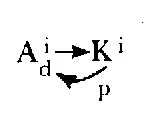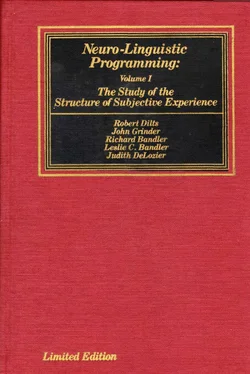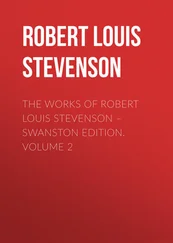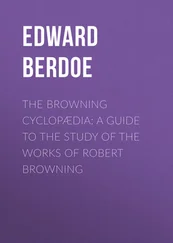As an illustration of these four well–formedness conditions, consider the following example of a decision making strategy which violates all of the well–formedness conditions. One of the authors was working with a woman who was experiencing a great many unnecessary problems in her life because of her inability to make decisions. The author elicited her decision making strategy and found that it essentially consisted of one two point loop. Whenever it was necessary for her to make a decision she would begin by proposing one of the possibilities to herself verbally. She would then get a feeling about what it would be like to be doing that particular activity. As soon as she got that feeling, however, she would have an auditory polarity response in which a voice would tell her that she should do something else which the voice would then specify. Just as she would get a feeling for doing the second alternative proposed by the voice, the voice would cut in again and tell her she should be doing something else. She would wind up bouncing back and forth among the various options available to her but would never be able to choose any of them because of the polarity loop, until some external experience would finally force her into choosing one of the alternatives. If there was no external intervention, however, she would sometimes spend days at a time literally immobilized, either lying in bed or sitting around her house.
Obviously the strategy did not contain all of the representational systems, nor did it achieve the outcome of successful decision making. It contained no external checks and represents a classic example of the two point loop:

The author designed a new strategy for the woman that contained two visual steps. She was to begin the strategy by looking externally at a clock and at other conditions in her external environment (V e). She was next to tell herself how much time she had to make her decision (A i d); this was based on what kind of decision was to be made but was not to exceed an hour unless there were unusual conditions. She was then to make an explicit internal image of the clock in her mind's eye, showing what time it would be at the completion of her decision (V i)- After getting a feeling for the amount of time she had (K i), she would check the clock to see how much time had elapsed (V e) and propose her first option to herself verbally (A i d). The following step was to make an image of what would be involved in the task and outcome (V i). After she could see these details she would get a feeling for what it would be like to carry out that option (K i). Then she was to check the clock again (V e) to assess her progress in relation to the time limit, and propose possibility number two to herself verbally (A i d), picture (V i) what was involved and check out how she felt about what she saw (K i). She was to check the clock again (V e) and repeat this operation until she saw that time had run out, at which point she was to tell herself (A i d) that time had run out and that she would now make her decision. She was to look at all the images she had made of the various possibilities (V i) and begin to carry out the one that felt the best to her (K i). This new strategy proceeded in the following manner:

The strategy was installed and tested on the spot by having the woman utilize it to make an important decision that she had been putting off for weeks.
In many cases where a person is looping in a strategy between a number of possible alternatives, as in the instance just cited, or when a person is having motivational problems, we will design into his strategy a representation we call the "outcome sequitur." The term means that which follows the outcome — what happens after the outcome has been achieved.
For instance, rather than simply designing and installing a strategy for a student to achieve the outcome of writing a term paper, we might also include a representation of what his experience would be like after the paper is finished as part of the outcome. Similarly, instead of having an alcoholic concentrate on the outcome of stopping his drinking habit, we would have him consider what he would be doing if he weren't drinking — as part of his outcome. This type of maneuver can often automatically positively reframe the person's experience of the specific task he is trying to accomplish by putting it into perspective with a larger train of events.
Considering the implications or outcomes of a particular outcome you are attempting to secure also has important ecological value especially if you are involved in working with businesses, organizations, families or in political situations where every outcome will propagate a series of responses from others involved in the system. The ability or inability to achieve an outcome may be based on secondary gains or contextual conditions that are not uncovered until the outcome sequitur is explored. These ecological considerations will be covered in more detail in the next section of this book.
5.312 RULES OF THUMB IN DESIGN
The purpose of design is to maximize efficiency and ease in achieving a particular outcome. There are other considerations that, although they are not well–formedness conditions, you should keep in mind while designing strategies: 1) When possible, choose the strategy that has the fewest steps — this is the modeling elegance rule again; don't complicate the strategy if you don't need to. 2) Having a choice is, in general, better than not having a choice — this goes back to the law of requisite variety mentioned earlier; variability in behavior is essential to adaptation. This also refers to the point we made earlier that the old strategies you are redesigning may still be useful in some contexts. When working with NLP you should never have to "get rid" of anything, only contextualize maladaptive behavior and design and install effective strategies. 3) When possible, opt for positive motivation when designing strategies. This is essentially an ecological consideration. Many individuals, and some institutions and organizations, have strategies that utilize negative motivation for achieving outcomes. Some people, for instance, have motivation or decision strategies that have tests that require a certain level of stress to be reached before the person will operate to access resources. The strategy keeps looping until enough stress is built up to anchor in a resource strategy. Others use punishment systems and aversive conditioning methods as motivators. And, although these methods are sometimes quite efficient and effective in securing outcomes in the short run, ecologically, because of the physiological effects of prolonged stress, pain, anger, and other negative visceral representations, they will often end up being detrimental to the health of the person or system. Also, we have found that negative anchors have a propensity to extinguish if not reinforced. Positive anchors, on the other hand, build in their own reinforcement.
The topics of negative motivation and requisite variety are only two of a number important ecological considerations that occur in strategy design. One of the most important questions to ask yourself when designing a strategy or choosing an outcome is, "Will it violate personal or organizational ecology?" Make sure that the strategy you design does not go directly against any other strategies that the client has. Sometimes there will be important reasons why an individual or organization hasn't achieved some particular outcome or developed a particular strategy.
Читать дальше













